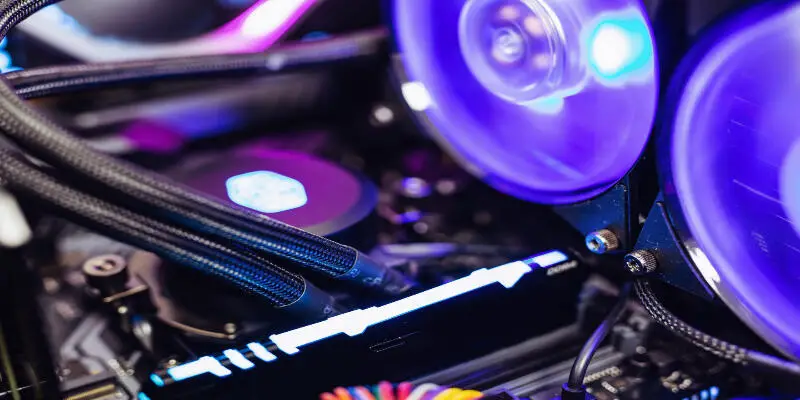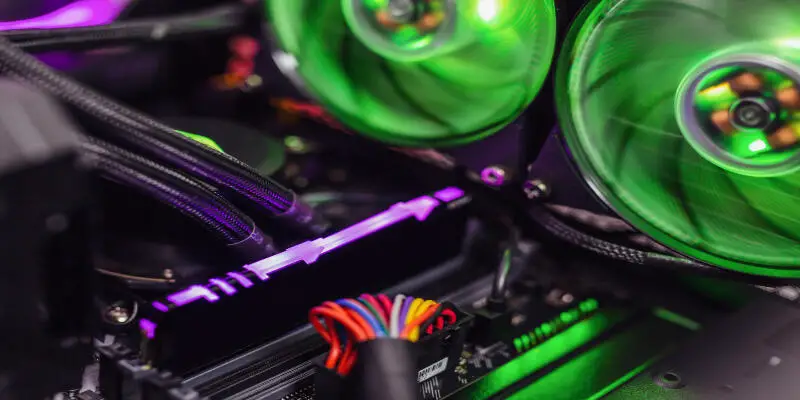Disclaimer: This post may contain affiliate links, meaning we get a small commission if you make a purchase through our links, at no cost to you. For more information, please visit our Disclaimer Page.
There are different methods you can implement to cool down your computer or other hardware. Currently, the most popular method is water or liquid cooling. Many people have switched from air cooling to their liquid counterparts and have experienced better results. But does water cooling need high-level maintenance to get the benefits?
Water cooling systems will need more maintenance than your standard air-cooling option. This is because water-cooled systems are typically more complicated and advanced. They also have more parts to help them perform. So, they usually require more care.
So, let’s look at whether a water-cooled system is worth the extra maintenance or not. In this article, we will explore how this system works, what you need to do to preserve it and the methods to test the system. Also, you’ll learn about the pros and cons of using a water cooling system.
Table of Contents
How does Water Cooling Work?
Water cooling or liquid cooling is the process of removing heat from a hardware or a machine with the help of a liquid.
Most of the time, water is the preferred liquid as it is non-toxic and has a high heat capacity. This cooling method is used in the internal combustion engines of automobiles and power stations.
Nowadays, most people associate water cooling with personal computers (PC). This water is circulated throughout the CPU or GPU of your PC and through heat transfer, removes excess heat from the hardware.
Types of Water Cooling Systems
1.All-In-One Water Cooler
This is the ready-made version of liquid-cooled systems. It is designed to give you the experience of a fully performing system without too much hassle. You simply have to plug it in and let it do its work. It is even easier to install than a lot of air coolers out there.
The problem is that this type of system is highly restrictive. So, you cannot upgrade your pc or any of its parts without changing the system first. So, the AIO is not ideal for people that run customized PC.
2.Customized Water Coolers
These are more advanced and require more expertise to properly build one. Basically, you build a cooling system that is perfectly suited to the PC setup you operate. Also, you can easily upgrade your hardware without having to buy a brand-new system .
The downside of this version is it is more expensive. Plus, it will require more care and attention and more technical know-how.
So, if you do not want to go through the troubles, then this option is not really for you. I recommend a customized PC for those who can afford it, have or are willing to learn the technical aspects of building a PC and will maintain it.
Parts of a Water Cooling System
Knowing the components of a liquid-cooled system will give you a better idea of the maintenance work involved. This may vary depending on the company that builds the system. However, the core elements of this system remain constant regardless of its manufacturer. These parts are:
Water Pump – As the name suggests, this part pumps the water and initiates the whole process. Normally, it is mounted in the center in front of the cylinder block.
Radiator – The function of a radiator is to take the heat from the traveling water and transferring to the air. Thus, the water is cooled, and it goes back to collect more heat from your PC.
Fan – Yes, even liquid dependent system requires a fan. The fan regulates airflow inside the system. The fresh air increases the efficiency of both the radiator and the circulating water.
Pipes/Tubes – This is like the conducting part of the entire system. The tubes carry the coolant (in this case water) throughout your PC and maintain a constant flow. It is here, where the exchange of heat from the hardware to the liquid occurs. These pipes loop around all the important parts.
Reservoir – This is extra water or liquid stored within a container. The additional fluid helps to keep a constant flow. So, you do not have to worry about the fluid running out and your PC getting hot.
So, the water pump drives the water from the reservoir through the pipes. When the relatively cooler water travels, the heat from the hardware transfers to the water.
Then the water reaches the radiator. The radiator takes the heat from the circulating water and disperses it in the air. So, the water becomes cool again and we repeat this process.
The fan keeps a consistent airflow so that the radiator can effectively pump out the extra heat. This is the basic process of how liquid cooling systems work.
Does Liquid Cooling Need Maintenance?
This type of system tends to need more attention and maintenance than air cooling systems. This is because this system has so many additional parts you have to think about. And a problem with any of the key parts will stop the system from working properly.
With a customized water cooling system, you have to periodically fill the water reservoir. Otherwise, the whole system may shut down. You would also need to check the individual parts after some time to see if everything works properly. And you have to be thorough with every single part.
Water or any other liquid might be a massive threat to the well-being of your hardware. Because they have the potential to fry all the electronics inside the hardware. So, you need to be very careful when checking for leaks.
The all in one (AIO) system requires less attention as it is simpler. However, if any single part needs to be changed, you will have to change the entire thing. So, this limits you a lot in terms of future upgrades to your hardware.
Another major hurdle with this system comes with repairing it. The water-cooled system is significantly harder to repair and fix than most other systems available. Partly because there are more parts and gears you have to worry about. Partly because the parts of this setup are not readily available in hardware stores.
You would need to drain the entire system before checking or repairing any parts of the circulation. Sometimes you may need to use hose clamps.
Liquid systems are heavier than standard air coolers. Now, there are very bulky air systems on the market. But those are the top-level, more expensive air systems.
The weight means that transportation is going to be more difficult for you. Since there are so many parts, it is better to just carry the entire structure.
All this maintenance and potential repair fees will not be cheap. The standard liquid setup is going to cost you more, to begin with. If you choose a custom setup (and many people do) then that will be even more expensive.
Keep in mind that if you intend to ship it out to get fixed, ensure it’s packaged well. If not, if the post carrier mishandles it and something breaks, maintenance costs will be more. Also, shipping costs are going to be pricey due to the weight and size of the package.
The Benefits of a Water Cooling System
Now, lets cover the many benefits of using a water-cooled system. There is a reason so many people prefer this setup despite the level of maintenance required.
So, let’s look at all the factors that give water-cooling an edge over its competition:
1.Increased Efficiency in Cooling
The heat capacity of water is higher than the air’s; meaning it can take in more heat before the water itself becomes hot. This offers more heat exchange and allows your hardware to cool down better.
2.Overclocking Potential
Simply put, overclocking your PC means running it at a higher speed than it was designed to. So, you can get significantly more out of your PC at a faster rate.
The downside is that this will cause your CPU to heat up exceptionally high. And if your cooling system is not efficient enough, it will permanently damage the PC.
This is where a liquid or water cooling system comes in. Since it has a higher degree of cooling, it can take on the extra load produced by overclocking. So, you can run your PC to its limit without worrying about the drawbacks.
3.Less Noise
You have most likely experienced the irritating noise of a traditional air-cooled arrangement. This can be extra frustrating if you work in an office environment. Because then you are disturbing the workspace for everybody.
With some exceptions, a water cooling kit will produce less noise than most fans. Plus, you may like the aesthetics of a water cooling system.
4.Sustainable in High-Temperature Climates
The condition surrounding your PC will also affect its performance. If you live in a very humid and warm climate, your hardware will heat up much faster.
But the increased efficiency of a water-cooled PC will negate that altogether. So, you can operate your PC in any part of the world.
5.Sustainable Over a Longer Period
We all have dealt with dust getting clogged in the cooling fan. It is not a pretty picture and can be hard to clean properly. But with a liquid cooler, there is not much chance of deterioration or dust build-up over time.
There are other things you have to look after with this setup. However, the chance of your cooler getting clogged with dust or other particles is not one of them.
Is Water Cooling Worth it?
Now then, let’s look at the other big question regarding this topic. This is something that most modern PC users have to deliberate. You know by now that water cooling needs more care and knowledge. But is the extra effort worth it?
To answer this question, I am going to compare the pros and cons side-by-side to get a better view.
|
Advantage |
Disadvantage |
| Better cooling | Typically, more expensive |
| Allows overclocking your PC | Higher maintenance necessary |
| Less noise | Harder to repair |
| Suited for warmer climates | Potential leak |
| Longer sustainability | Heavier equipment |
Now, there are two big benefits of a water cooling kit that gives it the edge. First, you can overclock your hardware and increase its work rate. The other is that you can operate your PC in high-temperature climates.
There are two big drawbacks you have to consider. One is the greater maintenance effort, and the other is the cost.
Before you decide what cooling system you are going to get, it is wise to think about your situation and your need. Not everybody is going to use their PC the same way.
So, the benefits of a liquid cooling system may not be as practical for you as they would be for others.
So, here is what I recommend you should do: ask yourself the following questions:
- Are you looking to overclock your PC?
- Can your budget handle the expense?
If the answer to both questions is “yes”, then the water cooling system will definitely suit you. All you have to do is learn the proper way to test and maintain this system and you will be good to go.
However, if you answered “no” to these questions, then I would not recommend the water-cooled kit for you. Because for standard activity and performance, you will not need to overclock your PC. And if you are not overclocking, then it is not worth the cost to go for the more luxurious option.
A customized cooling system is not for everyone. People who know the in and out of their hardware can maximize this sort of setup. Usually, these are dedicated gamers, software engineers, or something to that extent.
The liquid-cooled system is for those who demand the maximum from their hardware. These people will push their setup to the limit. So, they benefit from a cooling system that will allow them to achieve that limit.
But for everyone else, that much power is not needed. The standard, built-in cooler is often enough to perform routine tasks. If you want, you can get a more advanced fan at a much cheaper price.
Here is another test you can do to see if the liquid system is for you. Measure just how hot your PC or other hardware gets when you are doing heavy work. Usually, it is best to keep the temperature under 80 degrees Celsius. If it gets too hot, it will hinder your performance.
Now, a quality air cooling system will manage the heat when it is somewhere around 70-80 degrees. The really high-tech fans will be able to operate at a much higher temperature.
But if this is the range your PC is working in, then you do not need to change it. It is better to buy a better fan.
However, if your hardware is reaching levels closer to 90 degrees or even 100, then you should think about a different setup. At this high temperature, water cooling will be more efficient in removing the heat.
This happens when you are trying to work your hardware beyond the manufacturer’s standard.
You can check here to get a better idea of the temperatures regarding any computer.
Final Verdict
Install a water cooling system when you know you will be overclocking your setup and you have the budget for it. Otherwise, go with the standard cooling option.
That will save you both money and potential headaches. Just make sure the air-cooler is of excellent quality.
Will Water Cooling Leak?
Probably the biggest concern with any liquid-cooled setup. You are pumping water through almost all of your hardware. And if that coolant somehow spills on your CPU, GPU, RAM, etc. it will most likely cause damage.
Now, water or liquid can leak from your cooler. Even though companies design this equipment by adhering to high-level of standard and safety protocols, accidents can still occur.
This can happen because of poor installation or defective products.
However, all is not lost if this happens. The water inside the reservoir is non-toxic, electrolyte-free, clean water. And custom-made computers are made to adjust to this type of accident. So, your hardware will not immediately malfunction if the water leaks.
How Do You Test Water Cooler?
Building a custom-made PC is already expensive. Then you add in the cost of a customized water cooler. So, water leaking from the tubes or pump is a nightmare scenario for any pc owner.
Luckily, there are tests you can perform to make sure this does not happen. The main test you need to do is the leak test.
Things you will need for this: some paper towels and a paper clip.
- First, disconnect the 24-pin from the motherboard as well as cables from other key components (CPU, GPU, etc.).
- Ensure that the fittings are all tight and secure. It is better to double or triple-check before this type of test.
- Strategically place the towels/tissues around the sockets and blocks. The towel will help you notice any water spillage. Plus, it will protect those places in case there is a leak.
- Use a paper clip to bridge the power supply. This will turn on the pump without powering any other part of the setup.
- Then slowly start to fill the reservoir with water or coolant. I suggest you do this with a squeeze bottle as that will give you more precision.
- Turn on the pump. The water will start to flow through the tubes and the process will properly begin. Pay close attention to the towels to see if they are getting wet.
- Remember to prevent the reservoir from emptying. Check if the water level has reached the bottom of the container. If it has, turn the power off and add in extra coolant and water.
- Repeat this process however many times it takes.
This test will reveal two things about your setup. It will show you whether there is any defective product inside your water cooling system. Additionally, it will reveal any mistake with the installation.
To give you a better idea of the whole process, here is a visual tutorial of the water leak test. Pay close attention and you will able to do this on your own.
How Long Should You Leak Test Water Cooling?
I recommend keeping this test up for 24 hours or at the bare minimum keep it up overnight. That should give you plenty of time to spot any slow leak.
You can never be too careful with this type of equipment. So, it is best to take your time with this process.
A water cooling system is a safe and effective method to improve the performance of your PC. But it is not necessary for everyone. If your situation calls for it and you can take care of the maintenance, this system will be more than worth it.



